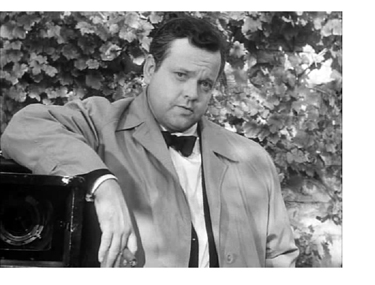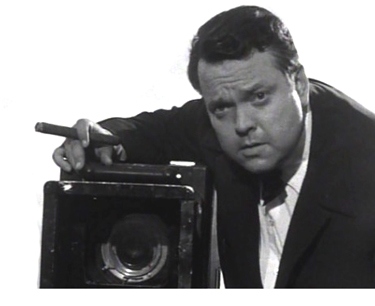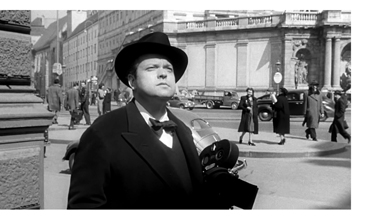
 |
|
|
|
In 1955 Orson Welles took time out from a score of simultaneous movie and theatrical activities to further overextend himself by committing to a British TV series. It's generally assumed that around this time Welles was grabbing whatever work he could find to advance his own self-funded films; he was beginning his long gestating, never finished Don Quixote project. He was also directing a Moby Dick play in London, and trying to make it into a movie of some description as well. The TV series Around the World with Orson Welles sounds, frankly, like the perfect venue for the born globetrotter and raconteur. Welles and a camera crew would simply travel to various exciting locations, where he'd describe the scenery and customs, and, where possible, introduce us to interesting people. And who better equipped to whip up great last-minute interview guests than Orson Welles? One would think the show-biz dervish could whip up a new half-hour show every couple of days. The shows are not without merit. They should have pointed a way for Welles to earn a solid income to finance his other artistic endeavors. Instead they're like other Welles projects of the period, brilliant but partly compromised for lack of the complete attention of their maker. But like everything else Welles did, it's obvious that he rigged the production so that nobody else could step in and finish the shows for him. We're left with six completed episodes that connect Welles to his radio roots, and invent a new kind of hosted travelogue perfectly suited to Welles' talents. Unfortunately, the shows were telecast over three months in late 1955 and forgotten by all but Welles devotees. Since then they've appeared in one fragmented form over another. One show was considered lost, but was found in 2011. This is the first time that all six half-hours appear together, along with a documentary made from the fragments of an unfinished 7th episode, that also discusses the entire project. 
The uniting factor of the series is disorganization and inconsistency -- factors that often yield good results. The first two episodes Pays Basque I (The Basque Countries) and Pays Basque II (La Pelote basque appear to be one episode spread out into two, when Welles overshot. Well, they're not really two full episodes, because both share the same opening and closing sequences; viewers of the second show might have thought they were watching a repeat. Welles goes to a small Spanish village on the French border, comments on the town and interviews a couple of locals. A shepherd who has lived in the U.S. is not a great interview subject, but he and his wife are certainly not typical subjects, and Welles does not patronize them. Another interview is with an expatriate American author who talks about desire to raise her son in a different country. Welles is careful not to give the impression that the U.S. is an unfit place to rear children. The second episode is about sports and music in the town. Welles includes a young fellow who translates the Basque language and explains a game of handball played with closed fists, and another ball game resembling Jai alai. We also see some fine, non-touristy Jota, a folk dance, performed. The interviews in these shows are natural and relaxed; Welles comes off as a fine intimate tour guide. Revisiting Vienna aka The Third Man Returns to Vienna is supposed to take us to places where The Third Man was filmed. We see some of those but by the mid-mark have done a lot of snooping around fantastic pastry kitchens. Welles doesn't hesitate to interview a woman with an insufficient command of English, but she comes off as authentic, a special person. This is the episode that was lost and rediscovered in 2011; this disc is reportedly the first time the entire series has been presented intact. 
The Paris episode St.-Germain-des-Prés is somewhat spotty; it has footage bought from another documentary to pad it out. Here's where we begin to think that Welles was disconnecting from the series. It is of interest for its glimpses and interview bits with a number of famous folk, the kind that might come running if Welles were to call: Jean Cocteau, Juliette Greco, Eddie Constantine, Simone de Beauvoir, Jean-Paul Sartre. We even get a glimpse of the then in-vogue Lettrist filmmaker, Isidore Isou, the 'auteur' of Venom and Eternity. Framing the show to some degree (and relieving Welles of constant host duty) are scenes of newspaper correspondent Art Buchwald typing in his office. Chelsea Pensioners sees Welles in London, enjoying himself interviewing a group of octogenarians living in a famous apartment building set aside 200 years ago for older widows; he then interviews some puffed-up old soldiers, complete with retirement uniforms and medals, at an old soldier's home, and also at their favorite pub. Welles brings out the cuteness in the old ladies and the pride of the old men. To some degree he's patronizing them but he's also laying down a filmic document of lifestyles that passed from the world without being well recorded elsewhere. Some of those soldiers may have fought in the Boer War, for instance. We also figure that Welles is choosing the episode content from his own experience. The old ladies' apartment is next door to a theater where he once worked. Madrid Bullfight shows the format falling apart to some degree. Excellent bullfight footage in Madrid is intercut with shots of Welles entering the arena. But he doesn't interview anyone. Instead, Welles is seen on a well-shot yet obvious set, commenting on the fight as if watching it live. Meanwhile, Welles must have walked out on the show before its completion, because Kenneth Tynan and his wife Elaine Dundy step in to share the narration, speaking to us from a very un-Wellsian two-shot. Tynan stutters a bit, which only makes him more interesting, and for 1955 they're fairly charming hosts. But the show itself has a strange disconnected feeling. 
Many clues convince us that Welles chose the content of the shows and wrote and edited them himself. The camera angles he chooses for his interviews are often inspired. Welles chats up some little Basque boys, some wearing dress-like smocks. The reverse angle is pointed up at him, and matches perfectly. Watching the Jai alai game, Welles sits with a group of boys, one of them his 'star' interpreter, an opinionated little kid he surely enlisted on location. It's all wonderfully natural. Welles' stories cover the people we see, the odd situation of being on the border with France, the fact that the language everybody speaks is officially outlawed by the Franco regime. That's when we realize the Welles is even cleverer than we think. He only has one sync sound setup, so only the interviewee half of the interview is filmed. Then Welles goes away, probably examines a transcript of what was said, and invents his question half of the interview, which is filmed separately. That they cut so well shows that he's writing and directing these little bits with all the attention he gave to his feature films. He uses his performing personality to smooth out any wrinkles, 'acting the role' of charming visitor-raconteur. The system works especially well when he's interviewing old ladies in London. His half of the give and take is indeed shot on the spot, he's less smooth and more human. He starts with an over-the-shoulder shot of himself with the ladies, and steps back out of the frame, to prove that he was there with them. Some interviews are better than others. But considering that Welles has 1,001 things to say on any subject, can feign an interest in just about anybody, and can BS his way out of any social corner, this format seems ideal for him. All he might need is a collaborator to make things even easier for him. The right person might even conduct some of the interviews, leaving Orson to fake his side. We might actually be fooled. The system really breaks down in the bullfight show, with the need for the co-hosts. Welles' reaction shots and commentary is obviously faked, not because of any overt mistake but because he's supposed to be in the arena with the crowd. The din of the crowd would make impossible the clear voice recordings we hear. When Welles is sitting with some Basque kids or flirting with toothless old ladies on a London street (where he even has to fend off hecklers in the background), he's in fine form. When he's commenting around somebody else's docu footage, things aren't so special. I have a feeling that Welles wouldn't delegate responsibility, wore himself out filming these shows, and soon lost interest in them. 
Since Welles finished only one half of the interviews on location for several of the shows, nobody else could finish them. Putting together studio sets for his half of the interviews was an added cost, and the producers had to wait until Welles had the time to write, film and edit each show. As Welles at this time was hard to pin down, flitting from country to country in search of money or filming a bit of this project or a bit of that project, getting these TV shows finished must have been murder for the backers. Perhaps Welles felt that the work would not generate enough money to fund his other ventures. A seventh episode was not completed, but it promised to be quite different. In it Welles and a journalist invaded the French town of Lurs, where a trial was underway for the murder of an English chemist, his wife and young daughter. They interviewed everyone involved in the case before the filming was halted. Opinions vary but the prevailing rumor is that the French authorities didn't appreciate Orson Welles getting involved; the scandal was bad enough without it being blown up to "War of the Worlds" proportions. In 2000, the footage from the unfinished show, with new interviews and clips from the other shows, was edited by Christophe Cognet into the 52-minute documentary The Dominici Affair, aka The Tragedy of Lurs. It looks as though Welles' original show departed from the travelogue format into something more like "60 Minutes," a format that was ten full years in the future. Cognet analyzes Welles' style and looks for answers as to why the show wasn't completed, and pushes the theory that the French government got involved. 
B2MP's Blu-ray + DVD of Around the World with Orson Welles puts the six half-hour episodes and the one double-length docu on one Blu-ray disc, with a DVD copy. The film quality is consistent throughout, with only the title sections varying in quality. Shots of a camera intrude here and there, possibly to serve as a background for a sponsor's message, to be added with superimposed graphics. We're told that the confusion was such that Welles hadn't finished his voiceover for one episode, and was forced to 'phone' it in live as the show was being broadcast. This sounds like something done to get attention and embellish the Welles legend, and he was certainly capable of doing such a thing. Whenever one of the docus runs for more than a few seconds without a commentary, we find ourselves wondering if we're looking at an episode for which the voiceover hadn't been fully recorded! My review disc did not come with a text insert; the release is said to include an essay by author Peter Tonguette. At this writing the Amazon listing for Around the World with Orson Welles shows no availability, but that will probably change momentarily. It's definitely available at the B2MP website. Sorry, Orson Welles fans, but this is another worthy disc of his work that you're going to need to put on your 'must see' list.
On a scale of Excellent, Good, Fair, and Poor,

The version of this review on the Savant main site has additional images, footnotes and credits information, and may be updated and annotated with reader input and graphics.
Review Staff | About DVD Talk | Newsletter Subscribe | Join DVD Talk Forum |
| ||||||||||||||||||